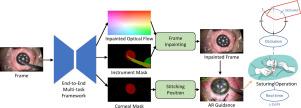基于ar的DALK手术导航的联合学习迭代模块实时跟踪和绘图网络
IF 4.8
2区 医学
Q1 COMPUTER SCIENCE, INTERDISCIPLINARY APPLICATIONS
引用次数: 0
摘要
背景与目的:深前板层角膜移植术(Deep anterior lamellar角膜移植术,DALK)是一种广泛应用于眼部疾病的治疗方法,在缝合过程中需要准确均匀的缝合位置。在这方面,增强现实(AR)导航系统的使用在增强缝合过程中显示出很大的潜力,并且角膜区域的清晰和无遮挡视图将帮助外科医生更好地规划缝合位置。方法:在这项工作中,我们提出了一个基于ar的缝合导航联合学习迭代网络。该网络旨在提高缝合过程中严重闭塞情况下的修复性能。它可以提供原始仪器和彩色角膜面罩以及彩色镜框。该网络基于特征重用、迭代模块和掩码传播结构,大大降低了计算成本。针对端到端训练的需求,我们还提出了一种新的数据集合成方法,构建包含遮挡和未遮挡图像对以及掩模和光流注释的数据集。我们还开发了一种基于网格传播方法和内涂光流输出的新型管道,以提供清晰稳定的内涂帧。结果:基于合成数据集,与最近优秀的绘画网络相比,我们的框架在性能和计算效率之间达到了更好的平衡。最终,我们的ter- s模型的平均端点误差(mEPE)为1.69,峰值信噪比(PSNR)为36.86,结构相似性指数(SSIM)为0.976,并且绘制推理时间较低,为16.26ms。在Iter-S的基础上,我们构建了一个帧率平均约为35.14ms/28FPS的AR导航系统。结论:基于迭代次数的选择,迭代模块可以逐步细化输出,同时在视觉性能和实时计算效率之间提供良好的权衡。我们的AR导航框架可以在严重闭塞的情况下实时提供稳定、准确的跟踪输出和绘制良好的结果,这说明了在角膜手术中指导外科医生缝合操作的好处。本文章由计算机程序翻译,如有差异,请以英文原文为准。

Real-time tracking and inpainting network with joint learning iterative modules for AR-based DALK surgical navigation
Background and Objective:
Deep anterior lamellar keratoplasty (DALK) is a widely used treatment for eye diseases and requires accurate and even stitch positions during the suturing process. In this regard, the utilization of Augmented Reality (AR) navigation systems shows promising potential in enhancing the stitching process, and a clear and unoccluded view of the corneal regions would help surgeons better plan the stitching positions.
Methods:
In this work, we present a joint-learning and iterative network for AR-based suturing navigation. This network aims to improve the performance of the inpainting under serious occlusion in the suturing process. And it can provide both original instruments and inpainted corneal masks along with inpainted frames. The network is based on feature reuse, iterative modules, and mask propagation structures to greatly reduce the computational cost. For the requirement of end-to-end training, we also propose a novel dataset synthesis method to construct a dataset with both occluded and unoccluded image pairs, along with mask and optical flow annotations. We also develop a novel pipeline based on the grid propagation method and inpainted optical flow outputs to provide clear and stable inpainted frames.
Results:
Based on the synthetic datasets, compared to the recent outstanding inpainting networks, our framework reaches a better trade-off between performance and computation efficiency. Our Iter-S model finally gets a mean endpoint error (mEPE) of 1.69, a peak signal-to-noise ratio (PSNR) of 36.86, and a structure similarity index measure (SSIM) of 0.976, along with a low inpainting inference time of 16.26ms. Based on the Iter-S, we construct a novel AR navigation system with a frame rate of around 35.14ms/28FPS on average.
Conclusions:
The iterative modules can progressively refine the outputs while providing a favorable trade-off between visual performance and real-time computation efficiency based on the selection of iteration times. Our AR navigation framework can provide stable and accurate tracking outputs with well-inpainted results in real time under severe occlusion conditions, which demonstrates the benefits of guiding the stitching operations of surgeons in corneal surgeries.
求助全文
通过发布文献求助,成功后即可免费获取论文全文。
去求助
来源期刊

Computer methods and programs in biomedicine
工程技术-工程:生物医学
CiteScore
12.30
自引率
6.60%
发文量
601
审稿时长
135 days
期刊介绍:
To encourage the development of formal computing methods, and their application in biomedical research and medical practice, by illustration of fundamental principles in biomedical informatics research; to stimulate basic research into application software design; to report the state of research of biomedical information processing projects; to report new computer methodologies applied in biomedical areas; the eventual distribution of demonstrable software to avoid duplication of effort; to provide a forum for discussion and improvement of existing software; to optimize contact between national organizations and regional user groups by promoting an international exchange of information on formal methods, standards and software in biomedicine.
Computer Methods and Programs in Biomedicine covers computing methodology and software systems derived from computing science for implementation in all aspects of biomedical research and medical practice. It is designed to serve: biochemists; biologists; geneticists; immunologists; neuroscientists; pharmacologists; toxicologists; clinicians; epidemiologists; psychiatrists; psychologists; cardiologists; chemists; (radio)physicists; computer scientists; programmers and systems analysts; biomedical, clinical, electrical and other engineers; teachers of medical informatics and users of educational software.
 求助内容:
求助内容: 应助结果提醒方式:
应助结果提醒方式:


